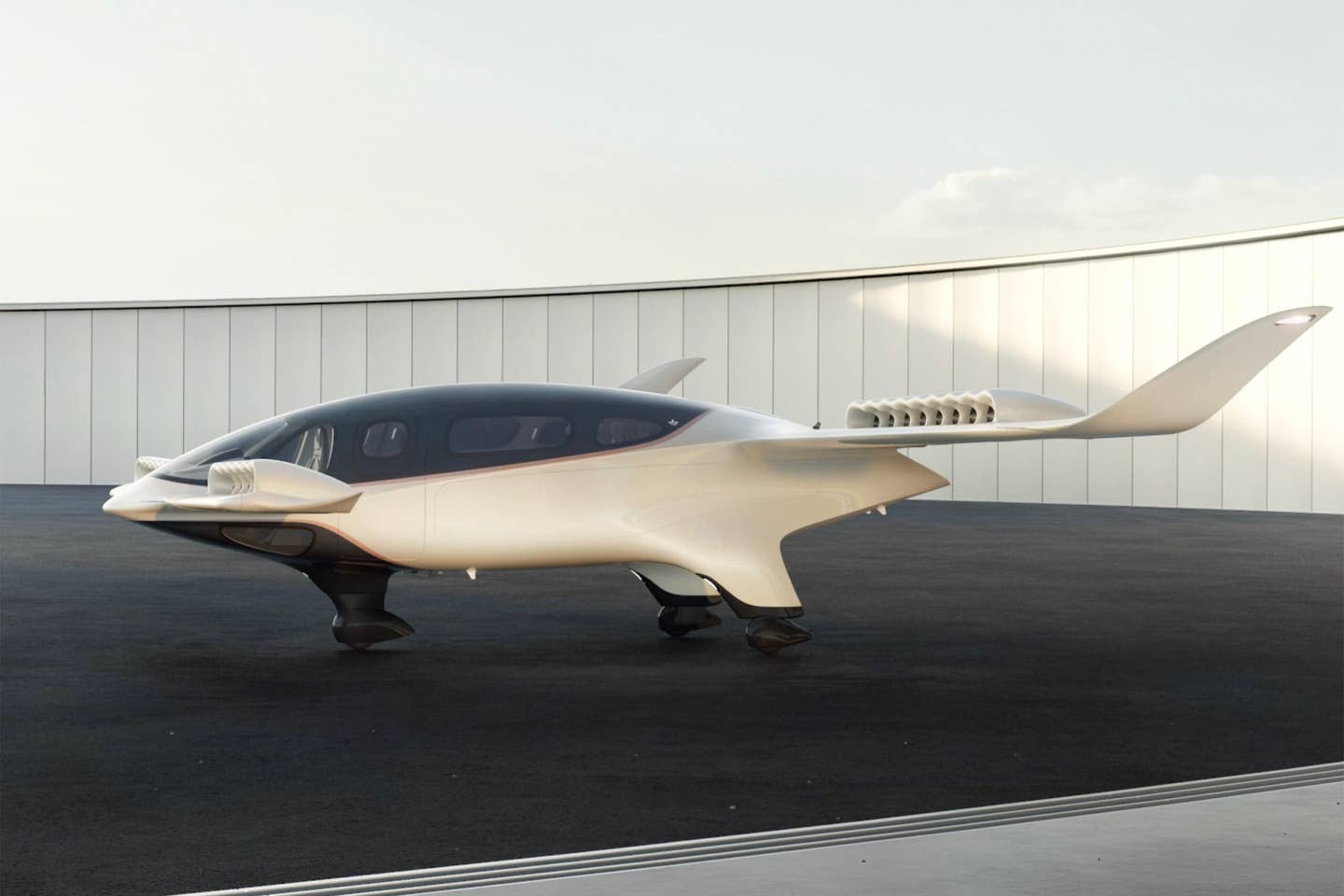Lilium Tweaks Its eVTOL Design for Short Running Landings
Gear for Germany-based Lilium’s electric vertical takeoff and landing (eVTOL) production aircraft will allow pilots the option for short running landings in addition to vertical landings.

Imagery shows the finalized preliminary design for the Lilium Jet, including newly added traditional landing gear and canard winglets. [Courtesy: Lilium]
Germany-based Lilium (NASDAQ: LILM) has revealed a key design change in its electric vertical takeoff and landing (eVTOL) aircraft currently under development: the addition of traditional landing gear.
Engineers said adding tricycle landing gear to the finalized preliminary design of the Lilium Jet will offer pilots the option to execute short running landings as an alternative to landing vertically.
“This will give our customers additional reassurance of safety, flexibilIty and operating range,” said a company letter to shareholders released last week.
The change, said Lilium chief technology officer Alastair McIntosh, is about managing precious available energy during all situations in the battery-powered aircraft. The Lilium Jet is designed to carry a pilot and six passengers with a maximum takeoff weight (MTOW) of 3,175 kg (7,000 pounds).
‘Real-World Scenarios’
For any eVTOL, the transition from horizontal flight to vertical landing and then hovering to touchdown typically requires significant amounts of battery energy. McIntosh said designing the aircraft with a running landing capability will be important to the aircraft’s certification by the European Union Aviation Safety Agency (EASA) and other aviation regulators “because it increases reserve range to address the jet’s ability to deal with real-world scenarios and be able to divert to an alternate landing site.”
Speaking in a newly released company video, McIntosh reminded viewers that transition is “the most difficult maneuver that a VTOL aircraft can undertake.” In fact, after years of test flights with full-sized prototypes, Lilium announced last month it had successfully achieved transition with a demonstrator aircraft for the first time.
Lilium is just one of several companies currently developing eVTOL passenger aircraft. While many other eVTOL air taxis are propelled vertically and horizontally by tilt-rotor systems, the Lilium Jet uses an array of ducted fans embedded across the aircraft’s wings and forward canards.
This isn’t the first major change to the design. Last January, Lilium revealed it was tweaking its ducted fan array—reducing the number of propulsors from 36 to 30—nine on each wing and six on each canard. As a result of the change, engineers said fewer batteries were required to power the aircraft, thereby reducing its overall weight while maintaining the same total thrust efficiency.
Batteries Are Key to Success
Lilium acknowledges that the batteries powering the aircraft are “at the core” of its architecture. Engineers have chosen cell technology developed by Zenlabs and manufactured by Germany-based Customcells. The design of these batteries is exclusive to Lilium and described as “one of the highest performance cells for practical use in eVTOL aircraft in existence today.”
Based on independent test results, these cells can support a high specific power density of 2,500 watts per kilogram, even down to 20 percent state of charge,” said McIntosh.
As battery technology improves, according to the letter, Lilium plans to upgrade its air taxi, which it said will result in “significant range and capability upgrades” over time.
Other Design Changes
Other changes to the Lilium Jet’s final preliminary design include:
- The aircraft’s rear wings were moved slightly upward and to the rear of the fuselage;
- Winglets were added to the tips of the canards;
- Redundant space was eliminated in the fuselage by decreasing the overall fuselage length, which reduced the eVTOL’s overall weight.
Lilium has been flying full-sized prototypes of its Phoenix test articles since 2019. Most recently, its Phoenix 2 demonstrator has been undergoing flight testing at ATLAS Flight Center in Villacarrillo, Spain.
‘Optimum Final Jet Architecture’
EASA certification of the Lilium Jet continues to move forward. Proposals have been submitted to EASA outlining how the aircraft will comply with certification requirements, which is part of the process for demonstrating airworthiness requirements outlined in EASA’s certification basis.
The company has long said its eVTOL will have an expected range of 200 km (108 nm) and a cruise speed of 300 km/hr (162 knots).
“We believe we’ve converged on an optimum final jet architecture that will meet the agreed certification requirements and achieve a projected physical range of approximately 250 km (135 nm) at launch, which is more than enough for our anticipated launch routes,” McIntosh said in a design update video.
Pending certification, the company has made provisional agreements with Brazilian airline Azul, which will purchase 220 Lilium Jets, and with U.S.-based NetJets, which will buy up to 150.
“We’ve successfully conducted a rigorous preliminary design review process,” McIntosh said. “We’ve converged on a final design which we have every confidence safely achieves the performance our launch customers require.”

Subscribe to Our Newsletter
Get the latest FLYING stories delivered directly to your inbox






